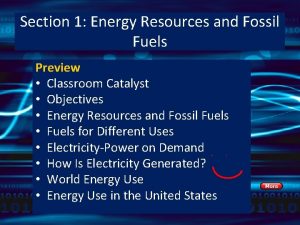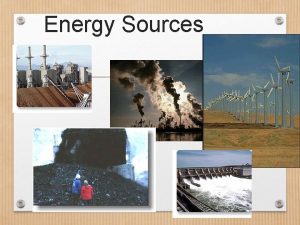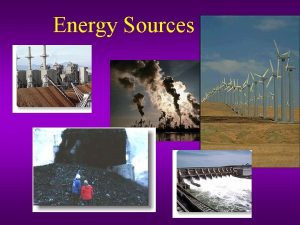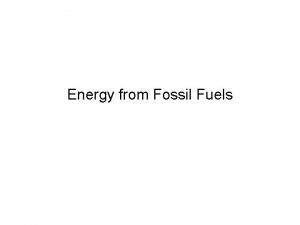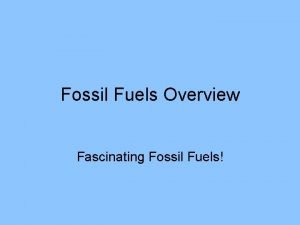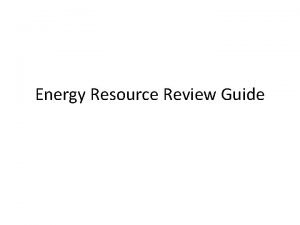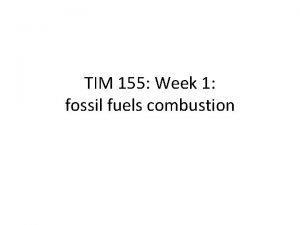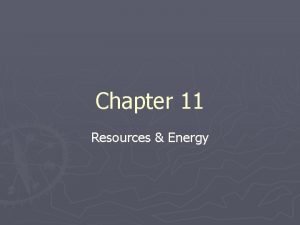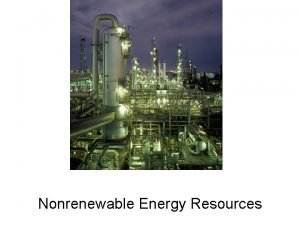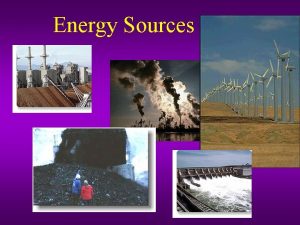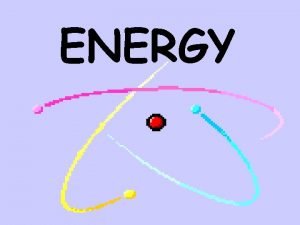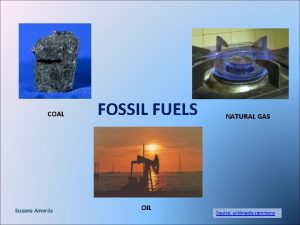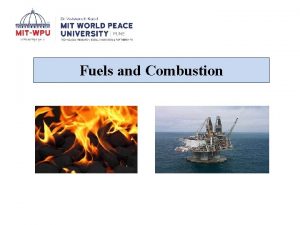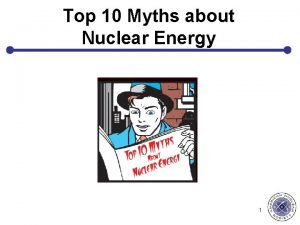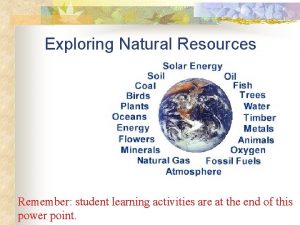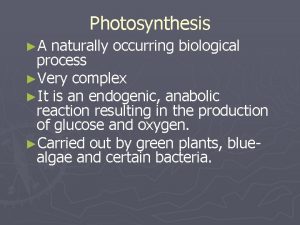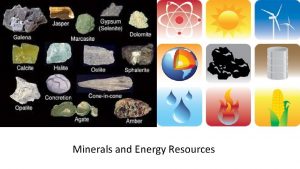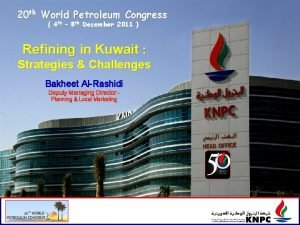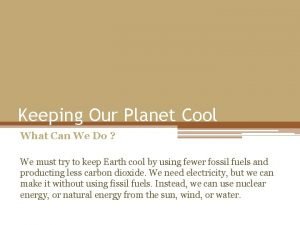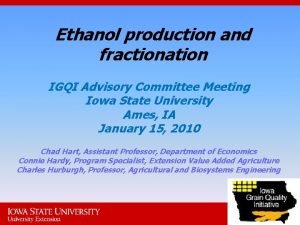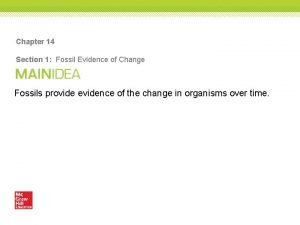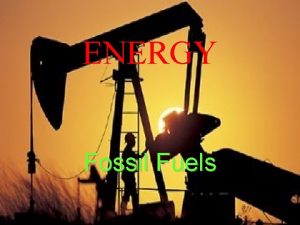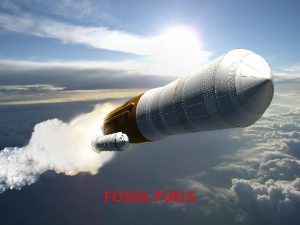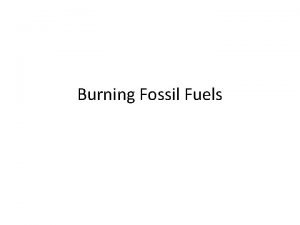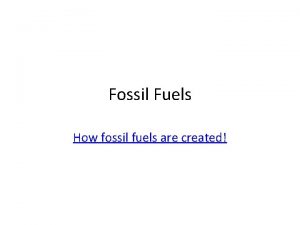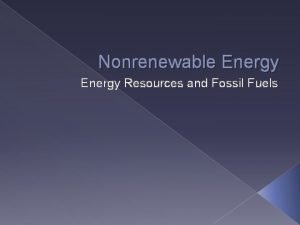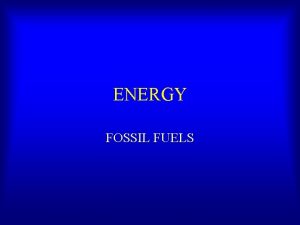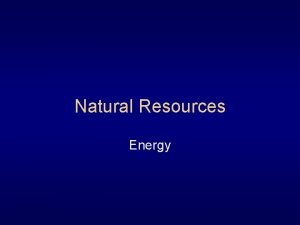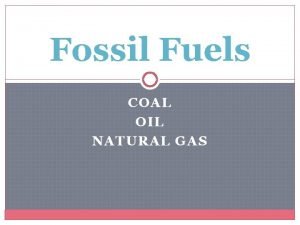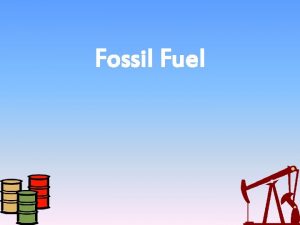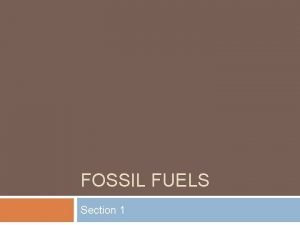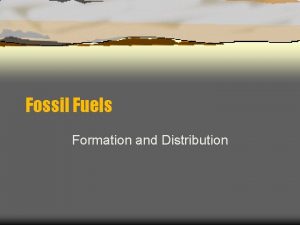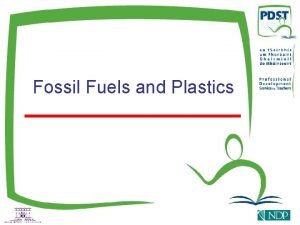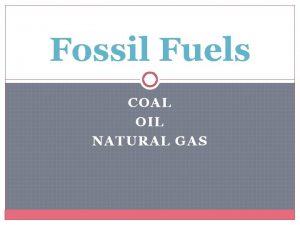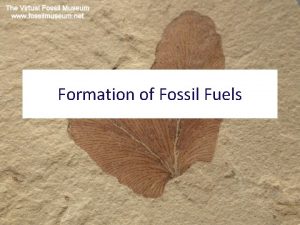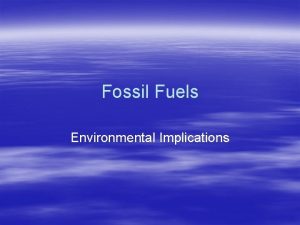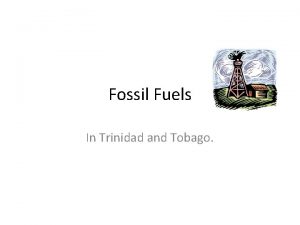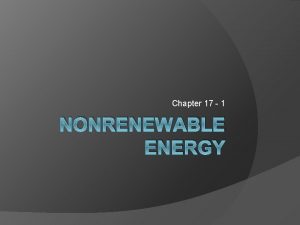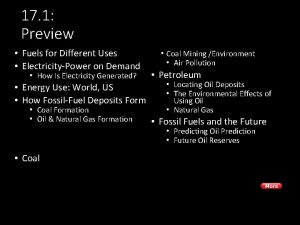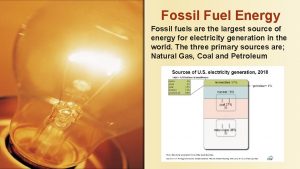Energy Fossil Fuels Chapter 5 Sections 2 Energy

























- Slides: 25

Energy – Fossil Fuels Chapter 5, Sections 2

Energy Resources are natural resources that humans use to generate energy.

How do we use fuel to make electricity? http: //phet. colorado. edu/en/simulation/genera tor

Two types of natural energy resources Renewable – can be replaced as quickly as used Or Nonrenewable – cannot be replaced as quickly as used

Fossil fuels Are nonrenewable energy resources formed from the remains of plants and animals that lived long ago.

Fossil Fuels include Coal – a solid black fuel formed underground from partially decomposed (rotting) plant material Petroleum – found as a liquid it is also known as crude oil petroleum can be refined into several different products including gas, jet fuel, kerosene, diesel fuel Natural gas – is a gaseous mix of hydrocarbons used mainly for heating and cooking. It is being used more each day for fuel because it causes less air pollution

Why nonrenewable? Petroleum and natural gas form mainly from the remains of sea organisms and coal forms from the remains of swamp plants. This takes millions of years to happen. As a result, our fossil fuel supply is quickly running out and we need to search for other fuels.

Other concerns with fossil fuels • The use of fossil fuels result in pollution in the environment. The gas given off when the fuels are burnt mixes with the rain resulting in acid precipitation (you may have heard of acid rain). This hurts wildlife, buildings, plants and statues.

Quick quiz (1 finger for yes, 2 for no) 1. 2. 3. 4. 5. Coal is a nonrenewable resource. All fossil fuels are nonrenewable. Petroleum comes from old swamp plants. Plastic is made from petroleum. Using fossil fuels causes acid precipitation.

Nuclear Energy What is it? When we split an atom (fission). A LOT OF ENERGY is given off. We call this nuclear energy. Is a nonrenewable energy BUT it takes such a little to make a lot of energy that we are not in danger of running out of it. Positives: lots of energy Negatives: radioactive wastes have high temperatures and cause sickness

Alternative Resources Alternative means option. What other options do we have to using fossil fuels?

Tidal Energy from using the movement of waves Positives – no pollution Negatives – limited areas

Solar energy The use of the sun’s power for heating or to create electrical energy. Positives – no pollution Negative – limited use in areas without a lot of sun

Wind power Wind is a by-product of solar energy. The uneven heating of the Earth results in wind. Windmills can turn and drive an electric generator. Positives – no pollution Negative – takes a lot of land space and is not possible where there isn’t a lot of wind

Quick Quiz 1) nuclear, 2) tidal, 3) solar or 4) wind A. This type of energy requires lots of land. B. This type of energy results in lots of radioactive waste C. This energy is clean, plentiful but only available in certain areas D. This energy comes from the movement of waves

Hydroelectric Energy The sun also drives the water cycle, evaporating water and dropping it back to Earth as rain. The movement of this water can be used to turn a turbine and produce electricity. Positives – no pollution Negative – need lots of land, destroys environment

Biomass/biofuel Plants absorb energy from the sun and store it. When biomass is burned it releases energy that can be used to heat or turn a turbine to create electricity. Positives – inexpensive, many sources Negatives – results in air pollution from burning

Gasohol Plants that contain sugar can be distilled and turned into liquid fuel. Positives – easily renewable Negative – requires lots of land that could be used for food

Geothermal Geo means earth and thermal means temperature. Where magma is close to the Earth’s surface that area can be used to heat water and pump it to the surface to use for heating or producing electricity. Positives – no pollution, all underground Negatives – only available in very limited areas

Quick Quiz 1) hydroelectric, 2) biomass, 3) gasohol or 4) geothermal A. B. C. D. Results from burning substances Requires ruining large environmental areas Is only available in certain areas Requires land plant matter that could be used for other uses, such as food

CRCT Practice – answer in notes 1. Name on way to conserve water. 2. What process releases energy that is used in nuclear power plants to generate electrical energy.

3. What determines whether a resource is renewable or not? 4. What type of energy is being used in this picture?

5. List two ways of conserving soil? 6. What are fossil fuels formed from?

7. Use the table to answer the question. Energy source Percentage of electric power generated Hydroelectric Power 82 Solid biomass power 11 Geothermal power 4 Wind power 3 What percentage of the electric power generated here came from sources that originated from the sun?

8. Name two nonrenewable energy resources. 9. What is the most common way to release biomass energy?
 Fossil fuel deposit
Fossil fuel deposit Disadvantage of solar energy
Disadvantage of solar energy Benefits of using fossil fuels
Benefits of using fossil fuels Advantage of fossil fuels
Advantage of fossil fuels Is petroleum a fossil fuel
Is petroleum a fossil fuel Similarities between biofuels and fossil fuels
Similarities between biofuels and fossil fuels Advantages and disadvantages of fossil fuels
Advantages and disadvantages of fossil fuels Fossil fuels include
Fossil fuels include Fossil fuels summary
Fossil fuels summary Fossil fuels include
Fossil fuels include Fossil fuels formula
Fossil fuels formula Fossil fuels
Fossil fuels Advantages and disadvantages of nonrenewable energy
Advantages and disadvantages of nonrenewable energy Benefits of using fossil fuels
Benefits of using fossil fuels Energy transformation of alarm clock
Energy transformation of alarm clock How does fossil fuel produce energy
How does fossil fuel produce energy Classification of chemical fuels
Classification of chemical fuels What are fuels used for
What are fuels used for What are fuels used for
What are fuels used for Resources that can be replaced
Resources that can be replaced Minerals and fuels
Minerals and fuels Minerals and fuels
Minerals and fuels Fuels
Fuels What are fissil fuels
What are fissil fuels Renewable fuels association
Renewable fuels association Chapter 14 study guide section 1 fossil evidence of change
Chapter 14 study guide section 1 fossil evidence of change
